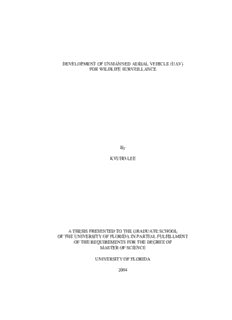
DEVELOPMENT OF UNMANNED AERIAL VEHICLE (UAV) FOR PDF
Preview DEVELOPMENT OF UNMANNED AERIAL VEHICLE (UAV) FOR
DEVELOPMENT OF UNMANNED AERIAL VEHICLE (UAV) FOR WILDLIFE SURVEILLANCE By KYUHO LEE A THESIS PRESENTED TO THE GRADUATE SCHOOL OF THE UNIVERSITY OF FLORIDA IN PARTIAL FULFILLMENT OF THE REQUIREMENTS FOR THE DEGREE OF MASTER OF SCIENCE UNIVERSITY OF FLORIDA 2004 Copyright 2004 by KYUHO LEE To my parents, wife, and daughter, In – myoung Park, Pan-hyi Lee, Nanyoung Seo, and Eugenia Lee. ACKNOWLEDGMENTS I have many people to thank for their assistance. I have confronted many difficulties during my academic career. However, I could not have overcome such difficulties without their support and help. In particular I am greatly indebted to my adviser, Dr. Peter Ifju, for providing me with the means and opportunity to work on this project. I would like to recognize Dr. Percival Franklin for all of his invaluable support. I also wish to thank my colleagues who have worked with me: Paul Barnswell, who was always a good friend and advisor; Sewoong Jung, who helped me adjust to life in America; Dragos Veiiru, who gave the best guide to CFD simulation; Danial Grant, who offered valuable help for building an airplane; Bret Stanford and Mike Sytsma, who were great contributors to designing and fabricating the air plane; Frank Boria, who has shared MAV research enthusiasm; Scott Bowman, who has assisted with testing the airplane, and Jangyoung Huh, who has spent considerable time assisting with thesis editing. To my family, I would like to say “I love you” rather than “thank you.” I love my mother, I love my daughter, Eugin, I love my wife, Nanyoung. I am glad to dedicate my thesis to them. iv TABLE OF CONTENTS page ACKNOWLEDGMENTS.................................................................................................iv LIST OF TABLES...........................................................................................................viii LIST OF FIGURES...........................................................................................................ix ABSTRACT.....................................................................................................................xiii CHAPTER 1 INTRODUCTION........................................................................................................1 1.1 Various Unmanned Aerial Vehicles.......................................................................1 1.2 Small Unmanned Aerial Vehicles (SUAV)............................................................2 1.3 Motivation of Development....................................................................................3 1.4 Thesis Objective.....................................................................................................4 1.5 Design Metrics........................................................................................................4 1.6 Related Work..........................................................................................................5 1.7 Technical Challenge...............................................................................................5 2 WSUAV REQUIREMENTS........................................................................................6 2.1 Mission Profile and Overview................................................................................6 2.2 Design Requirements..............................................................................................8 3 DESIGN OF WSUAV................................................................................................10 3.1 Consideration to Wildlife Application and Design..............................................10 3.2 Design Process......................................................................................................11 3.3 Wing Design.........................................................................................................11 3.3.1 Plan form Design........................................................................................13 3.3.2 Wing area and Airfoil estimation...............................................................15 3.3.3 Airfoil Design.............................................................................................17 3.3.4 Aerodynamic Calculation...........................................................................18 3.3.5 Computer Fluid Dynamics (CFD) Simulation...........................................21 3.3.6 Wind Dihedral ...........................................................................................23 3.4 Fuselage Design....................................................................................................25 v 3.4.1 Structural Cosiderations.............................................................................25 3.4.2 Consideration of Center of Gravity (CG)...................................................26 3.4.3 Lift-Dependent Drag-Factor, C ................................................................27 Di 3.4.4 Consideration of Hatch Design..................................................................28 3.5 Stabilizer Design..................................................................................................28 3.6 Propulsion system................................................................................................32 3.6.1 Electric Motor Selection.............................................................................33 3.6.2 Cooling Consideration................................................................................34 3.6.3 Battery Selection........................................................................................35 4 AIRPLANE FABRICATION.....................................................................................37 4.1 Wing Fabrication..................................................................................................37 4.2 Fuselage Fabrication.............................................................................................41 4.3 Stabilizers Fabrication..........................................................................................43 5 AVIONICS.................................................................................................................47 5.1 Avionics Configuration........................................................................................47 5.2 Kestrel Autopilot System......................................................................................50 5.2.1 Autopilot Control Theory...........................................................................52 5.2.2 The Virtual Cockpit Software....................................................................55 5.3 Camera and Recording System.............................................................................56 5.4 Ground Plane (GP) Antenna Design for Video Transmitter.................................59 5.5 Video Reception Maximization at the Ground Station.........................................64 5.6 Camera Switching Device Design and Fabrication..............................................67 6 AIRPLANE EVALUATION......................................................................................69 6.1 Propulsion Evaluation...........................................................................................70 6.1.1 Comparison of Climb Rate at Take Off....................................................70 6.1.2 Comparison of Efficiency at Cruise..........................................................72 6.2 Autopilot Evaluation.............................................................................................76 7 CONCLUSION...........................................................................................................79 7.1 Conclusion............................................................................................................79 7.2 Future Recommendation.......................................................................................79 APENDIX .........................................................................................................................80 A LKH2411 AIRFOIL COORDINATES......................................................................80 B LKH 2411 SIMULATION DATA.............................................................................82 C EH 00/90 AIRFOIL COORDINATES.......................................................................84 vi LIST OF REFERENCES...................................................................................................85 BIOGRAPHICAL SKETCH.............................................................................................87 vii LIST OF TABLES Table page 1-1 The wingspan and flying time of the SUAV are compared.......................................3 2-1 Design requirements...................................................................................................8 2-2 WSUAV design objectives and constraints comparing SUV.....................................9 3-1 W/S comparison with other SUAVs.........................................................................14 3-2 WSUAV weight distribution, W (3.371 kg).............................................................15 3-3 T/W comparison with other SUAVs........................................................................19 3-4 CFD flows and pressure visualizations results comparison.....................................23 3-5 Tested stabilizer specifications.................................................................................30 3-6 Specification of electric motor.................................................................................34 3-7 Specifications of selected battery.............................................................................36 5-1 Electric devices in the avionics................................................................................49 5-2 Cameras specification as shown in Figure 5.12 and 5.13.........................................57 5-3 Antennas comparison of output power.....................................................................65 vi ii LIST OF FIGURES Figure page 1-1 UAVs can be divided into four groups by respect to its sizes and weights................2 2-1 Oscillating path survey...............................................................................................6 2-2 Random path survey...................................................................................................6 2-3 Diagram used to calculate the field of view of a camera view angle.........................7 2-4 Typical WSUAV’s mission profile............................................................................8 3-1 Design and manufacturing process...........................................................................11 3-2 Elliptical wing platform shape comparison..............................................................12 3-3 Typical effect of aspect ratio on lift..........................................................................12 3-4 LKH 2411 Airfoil at 2.5° AOA................................................................................17 3-5 Cl vs AOA for LKH 2411 & NACA 2411...............................................................17 3-6 Cd vs AOA for LKH 2411 & NACA2411...............................................................17 3-7 Cl/Cd vs AOA for LKH 2411 & NACA 2411.........................................................17 3-8 Cm vs AOA for LKH 2411 & NACA 2411.............................................................17 3-9 LKH 2411 Cl vs Cd..................................................................................................20 3-10 Tested wing platform comparison............................................................................21 3-11 CFD simulation for design one.................................................................................22 3-12 Vorticity simulation for design one..........................................................................22 ix 3-13 CFD simulation for design two................................................................................22 3-14 Vorticity simulation for design two..........................................................................22 3-15 CFD simulation for design three..............................................................................23 3-16 Vorticity simulation for design three........................................................................23 3-17 The final design of the right wing............................................................................25 3-18 Payload distribution in the fuselage..........................................................................27 3-19 Lift-dependent factor for fuselage interface.............................................................28 3-20 Tested stabilizer configurations................................................................................30 3-21 Side view..................................................................................................................31 3-22 Top view...................................................................................................................32 3-23 Front view.................................................................................................................32 3-24 Optimum condition of propulsion system................................................................33 3-25 Gravimetric energy density in various batteries.......................................................35 4-1 Master wing shape (right side) for the creating mold...............................................38 4-2 Female molds for the wings......................................................................................39 4-3 Wing manufacturing layout......................................................................................40 4-4 Before wing assembly..............................................................................................41 4-5 Assembled wing and joint pipe................................................................................41 4-6 Female molds for the fuselage..................................................................................42 4-7 Fabricated fuselage...................................................................................................43 4-8 Fabricated stabilizer..................................................................................................45 4-9 Disassembled modular parts fit into the one man carrying box...............................45 4-10 Assembled final design WSUAV.............................................................................46 5-1 WSUAV avionics configuration...............................................................................48 5-2 Kestrel autopilot system...........................................................................................50 x
Description: